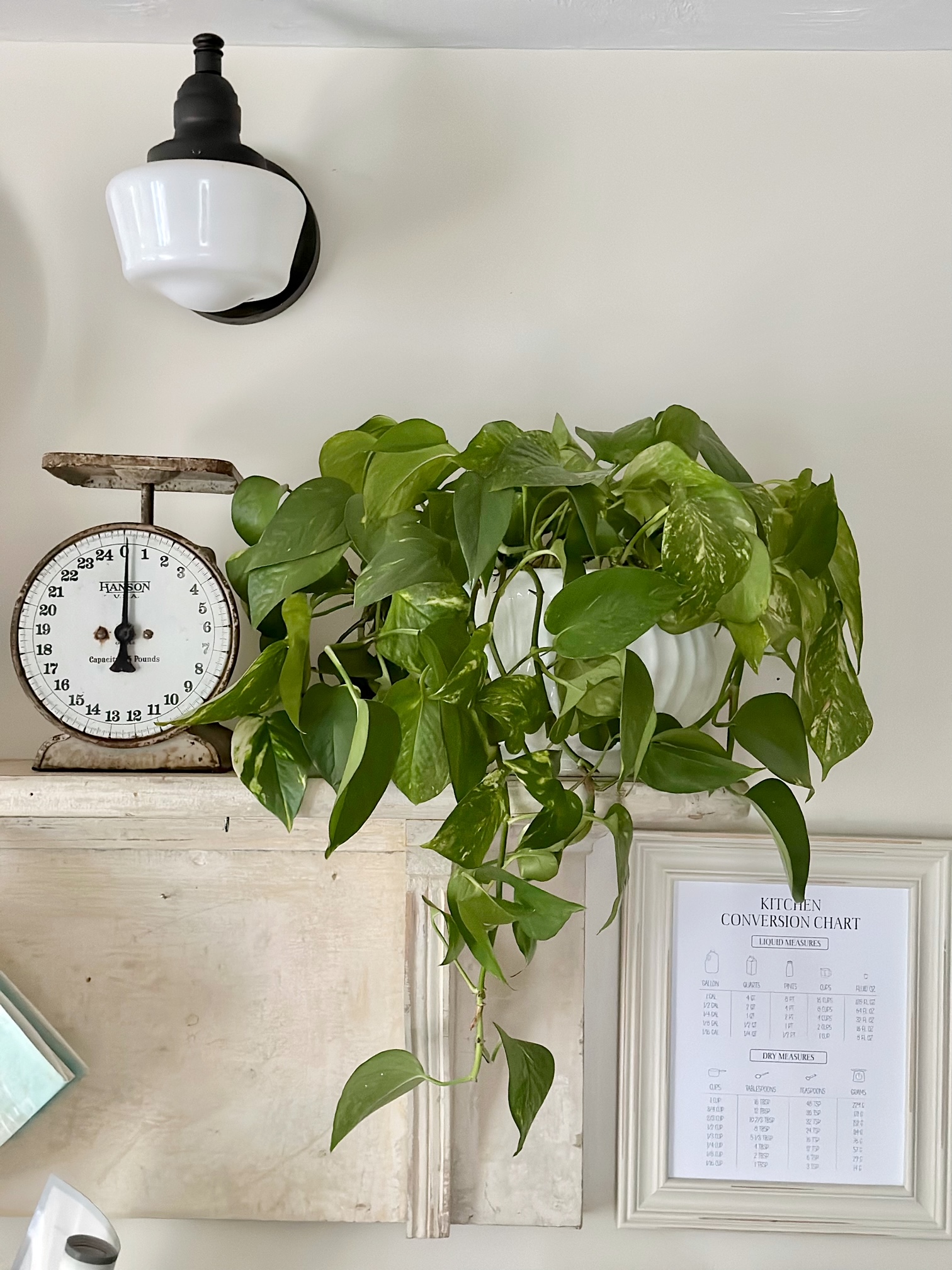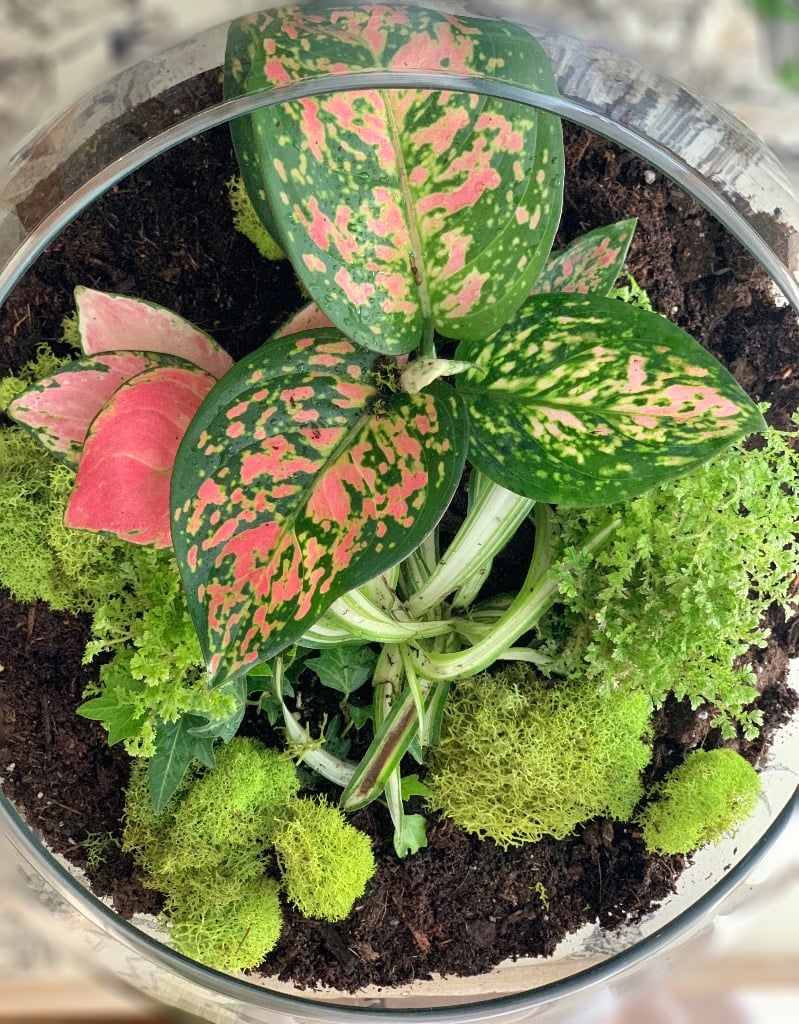As an avid plant lover, I've come home too many times to find my beautiful indoor houseplants looking sad and droopy. My spider plant's leaves are pointing toward the floor, my Pothos' normally perky heart-shaped leaves are bowed over, and my Ivy topiary's leaves are suddenly limp.
I'd give them a drink of water and cross my fingers, hoping they'd perk back up. Sometimes it worked, sometimes not. The truth is drooping, wilting plants are super common, but it can be frustrating trying to figure out the possible causes and the best way to nurse your plants back to health.
After years of trial and error, I've learned the major reasons why indoor plants end up drooping, how to diagnose the underlying problem, and the simple solutions to revive them. So if you've ever wondered "Why is my plant drooping even after I water it?" or "How can I fix my droopy plant?", read on for the handy guide to troubleshooting and fixing a drooping houseplant.

Content may contain affiliate links. When you shop the links, we receive a small commission at no cost to you. Thanks for supporting my small business.
Jump to:
Why your plant's leaves are drooping: Possible causes
When your plant's leaves start to droop, think of it as Mother Nature's way of sending you a message. It's like your green companion saying, "Hey, something's not quite right here!" Those sagging leaves could be trying to tell you they're thirsty, craving more sunlight, or even hinting at a need for some extra TLC. So, don't fret when you see droopy foliage; instead, consider it a gentle nudge from your plant, asking you to investigate and give it the care it deserves.
With a little attention and the right adjustments, you'll have your leafy friend standing tall and thriving again in no time! A drooping, wilting plant with leaves pointing downward is a common symptom of a wide range of problems. Here are some of the most frequent offenders:
Underwatering
If your drooping plant's soil moisture is bone dry, the number one reason is likely underwatering. When plants don't get enough moisture, their leaves droop and wilt as the plant's tissues lose turgor pressure which keeps them rigid. The lack of water prevents the plant from taking up nutrients via the roots.
In my home, this is the most common reason for my wilted plants. Anything that is not in one of my DIY self watering planters get a quick sink soak. This typically does the trick!

Overwatering
It may seem counterintuitive, but giving your houseplants too much water can also cause yellow, droopy leaves. Excess water deprives the roots of oxygen, leading to root rot. It also leads to a buildup of water in the plant's root system, preventing proper nutrient absorption. Explore my DIY Self-watering planters to ensure your plants receive just the right amount of water they need!
Comparison Chart: How to Spot the Difference: Underwatered or Overwatered?
| Underwatered Houseplant | Overwatered Houseplant |
|---|---|
| Dry, crumbly soil | Wet, soggy soil |
| Wilting, drooping leaves | Yellow or brown spotted leaves |
| Crispy, curled leaf edges | Mushy, translucent leaves |
| Stunted new growth | Leaf drop |
| White crusty deposits on pot | Evidence of mold or rot |
| Few blooms | Root rot |
| Needs more frequent watering | Needs less frequent watering |
Improper light
Plants need the right amount of light for their specific needs. Low-light indoor plants may droop and wilt if they're getting too much harsh direct sunlight. On the flip side, high-light plants like fiddle leaf figs aren't getting enough light without several hours of direct sunlight or very bright grow lights.

Learn about the best potting soil for your spider plants.
Transplant shock
If you recently repotted your plant or brought it home from the nursery, the stress and change in environment can cause leaves to droop for a period of time as it adjusts. This transplant shock from changes in light, humidity, and growing space can put plants into a funk. Just give it extra love and time to adjust!
Rootbound
If your plant's roots are tightly packed into its container with no more room to grow, it becomes rootbound. This restricts water and nutrient intake, leading to lower leaves wilting. Time for a roomier pot!

(Roots circling and extending outside the pot is a sign the plant needs a larger pot.)
Extreme temperatures
Plants from tropical climates don't like temperature extremes. If your drooping plant is located in hot or cold drafts from heating and cooling vents, the stress can disrupt its water balance and nutrient uptake.
Pests
Common houseplant pests like spider mites, aphids, and fungus gnats damage plant tissues and roots, leading to wilting. Check the undersides of leaves and the soil for signs of insects if your plant is drooping.
Other causes
Drooping can also be caused by diseases like root, stem, or leaf funguses, bacterial infections, and nutrient deficiencies. Once you rule out the main reasons listed above, test for these other issues.

How to diagnose the cause of a wilting plant
Determining the reason your plant isn't looking perky will point you to the right solution. Follow these tips for diagnosing a droopy houseplant:
- Look at the whole plant - are just the older leaves drooping, or the younger leaves too? Are the stems and buds wilting as well?
- Check the soil moisture - is just the top dry, or is it bone dry when you stick your finger deeper into the soil? Or check with a soil moisture meter.
- Inspect the roots and lower stem - are the roots brown or mushy from rotting, or riddled with tiny pests?
- Consider any recent changes to its care or location. Did you just repot it or move it to a new home?
- Research the specific care the plant needs, like the ideal amount of water, sunlight, humidity and room temperature it thrives in.
Once you pinpoint the likely issue based on your observations, it's time to take steps to revive your sad, drooping houseplant.

Visit my post, How Often Should I Water a Pothos Plant? For tips on best watering practices to keep your pothos thriving!
How to fix and revive
Here are the go-to solutions for nursing a drooping indoor plant back to health based on the underlying problem:
- If overwatering, stop watering it altogether until the soil dries out, then improve drainage long-term with perlite or orchid bark mixed into the potting soil.
- If light conditions are insufficient, move the plant to a brighter location like an east-facing window, or install a full spectrum grow light. Remove direct sun-loving plants from the direct path of sunlight if too harsh.
- For rootbound plants, carefully remove from the pot and gently loosen roots before replanting into a bigger pot with fresh potting mix.
- Keep drooping plants away from hot and cold drafts. Maintain indoor temperatures ideal for tropical plants.
- Let newly transplanted or repotted plants rest and recover for a few weeks, gradually moving them back into brighter light and normal watering.
- Use a miticide for spider mites, neem oil for other pests, or a hydrogen peroxide flush of the root system for root rot fungus. Isolate and check nearby plants. For some helpful information on using hydrogen peroxide on your plants visit this helpful article from Gardening Know How.
- Switch to distilled water if hard tap water minerals cause leaf tip burn. Test soil to check for nutrient deficiencies and amend accordingly.
Sometimes fixing drooping leaves is as simple as changing one factor like moving it to a shadier spot or watering more frequently. But patience and attentive care is needed as your plant recovers and adapts to the modifications. With time, it should perk back up!

Keep your houseplants perky with proper prevention
While reviving droopy houseplants is possible, prevention is always preferable to reduce stress on your green friends. Here are some handy ways to help avoid limp, wilting plants in the first place:
- Closely inspect new plants before bringing them home. Look for any signs of pests like webs or eggs underneath leaves. Quarantine new plants for a few weeks before placing them in their new environment with existing plants.
- Use beneficial insects like ladybugs or lacewings to protect plants without chemicals. They eat many common pest larvae.
- Stick to a consistent watering regimen based on each plant's needs to make sure each plant gets enough water. Check the soil with your finger before watering, don't just water on a schedule.
- Ensure pots have adequate drainage holes. Consider lining pots with pebbles or gravel at the bottom for better drainage and airflow to roots.
- Rotate your houseplants periodically so all sides get equal sunlight exposure. This prevents one-sided growth.
- Mist plants regularly to increase humidity, especially for tropical plants. Use a humidifier in dry indoor environments.
- Remove dead leaves and trim back leggy growth to encourage new healthy growth and prevent disease.
- Avoid temperature extremes and cold drafts which can shock plants. Move plants away from heating/AC vents.
By being attentive and providing good care tailored to each plant, you can help your leafy friends stay happy, growing, and standing tall! A little prevention goes a long way.

Learn how to make a Grapevine wreath topiary.
Frequently asked questions
If your plant is still drooping after watering, it likely has root rot from overwatering. The damaged roots cannot take up moisture efficiently. Let it dry out completely and reduce watering to prevent future rot.
Brown crispy leaf tips are a sign of dry air. Increase humidity through a pebble tray or humidifier. Tap water chemicals and improper soil pH can also cause brown leaf tips.
Growth cycles, seasonal light changes, rootbound conditions, or accumulation of salt buildup can cause drooping even in established plant spots. Assess watering needs and repot or change fertilizer if needed.
Check the leaves - wilting indicates underwatering, while yellow/brown spotted leaves point to overwatering. The soil test can confirm - dry deep down is underwatered, constantly soggy is overwatered.
It's best not to prune droopy, wilting parts of a plant until you identify and treat the underlying cause. The drooping leaves can still recover. If leaves eventually die, prune them to direct energy to new growth.
It depends on the severity, but most plants begin to recover in 1-2 weeks after problems are corrected. Proper care must be maintained for complete recovery which can take 4-6 weeks for severely drooping plants. Be patient!
Fertilizer can be beneficial for droopy plants, but it's essential to use it cautiously. Drooping leaves can result from various issues, including too much fertilizer, so it's crucial to determine the specific cause of the drooping before applying fertilizer. If the droopiness is due to nutrient deficiencies, a balanced and diluted fertilizer can provide the necessary nutrients to help your plant regain its health and vitality. Learn how to make your own indoor plant fertilizer.
More plant care topics
Explore our collection of houseplant resources:
- Grow lush pothos without soil using our simple hydroponic setup that accelerates growth while preventing common dirt-related issues
- Uncover the real monstera lighting requirements with our research-backed guide to positioning these popular houseplants for stunning growth
- Nourish your aloe plants naturally with budget-friendly fertilizer options that promote healthy growth without harsh chemicals
- Master every aspect of Stephanotis plant care from planting to blooming with our comprehensive guide to this beautiful flowering vine
- Perfect your watering technique for Spider Plants with ten quick tips that prevent both overwatering and dehydration issues
These practical guides will help you develop confidence in your plant parenting skills and transform struggling houseplants into thriving, beautiful additions to your home.
Don't let your plants suffer from droopy leaves for too long! A quick diagnosis of common causes and simple solutions can help your wilted plant stand tall and healthy once more. By identifying the underlying issue and addressing it accordingly, you can nurse your plants back to vibrant health.
While it can be frustrating to see your once-healthy plant with droopy leaves, remember that it's not a death sentence for your houseplants. Just take it one step at a time, shower them with a little TLC, and soon those droopy leaves will return to their perky selves, making both you and your plants happy again!
Thank you for exploring my blog post titled "Why are My Plants Drooping? How to Revive Your Sad, Droopy Houseplants." We're passionate about plant care here at Celebrated Nest, and I hope you found this information helpful! If you're eager to become the best plant parent you can be, check out additional plant care articles that offer valuable insights and tips on caring for your leafy companions.
This is just one of many plant care tips I’ve shared — explore the full Indoor Plant Index for DIY projects, fertilizer recipes, and more.
Happy plant parenting friends! You got this!








